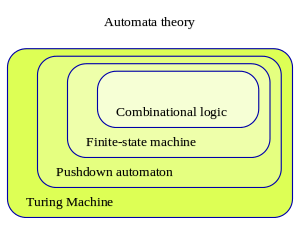Combinational logic


In digital circuit theory, combinational logic (sometimes also referred to as time-independent logic[1] ) is a type of digital logic which is implemented by Boolean circuits, where the output is a pure function of the present input only. This is in contrast to sequential logic, in which the output depends not only on the present input but also on the history of the input. In other words, sequential logic has memory while combinational logic does not.
Combinational logic is used in computer circuits to perform Boolean algebra on input signals and on stored data. Practical computer circuits normally contain a mixture of combinational and sequential logic. For example, the part of an arithmetic logic unit, or ALU, that does mathematical calculations is constructed using combinational logic. Other circuits used in computers, such as half adders, full adders, half subtractors, full subtractors, multiplexers, demultiplexers, encoders and decoders are also made by using combinational logic.
An alternate term is combinatorial logic,[2] though this usage may be considered controversial.[3]
Representation
Combinational logic is used to build circuits that produce specified outputs from certain inputs. The construction of combinational logic is generally done using one of two methods: a sum of products, or a product of sums. A sum of products can be visualized in a truth table, as in this example:
| Result | Logical equivalent | |||
|---|---|---|---|---|
| F | F | F | F | |
| F | F | T | F | |
| F | T | F | F | |
| F | T | T | F | |
| T | F | F | T | |
| T | F | T | F | |
| T | T | F | F | |
| T | T | T | T |
Using sum of products, all logical statements which yield true results are summed, giving the result:
Using Boolean algebra, the result simplifies to the following equivalent of the truth table:
Logic formula minimization
Minimization (simplification) of combinational logic formulas is done using the following rules based on the laws of Boolean algebra:
With the use of minimization (sometimes called logic optimization), a simplified logical function or circuit may be arrived upon, and the logic combinational circuit becomes smaller, and easier to analyse, use, or build.
See also
- Sequential logic
- Asynchronous logic
- FPGA
- Formal verification
- Relay logic
- Programmable logic controller
References
- ↑ C.J. Savant, Jr.; Martin Roden; Gordon Carpenter. "Electronic Design: Circuits and Systems". 1991. ISBN 0-8053-0285-9 p. 682
- ↑ Clive Maxfield. "FPGAs: World Class Designs". p. 70. 2009. ISBN 1856176215
- ↑ Cliff Cummings. "Common Mistakes In Technical Texts". 2009.
- Michael Predko and Myke Predko, Digital electronics demystified, McGraw-Hill, 2004. ISBN 0-07-144141-7
External links
- Combinational Logic & Systems Tutorial Guide by D. Belton, R. Bigwood.